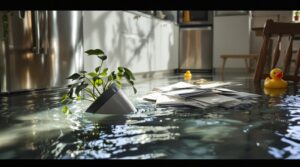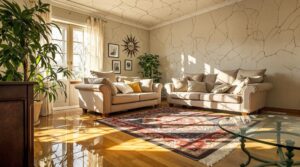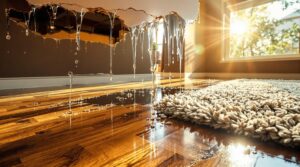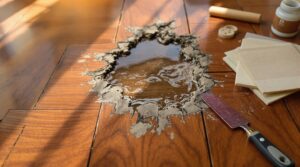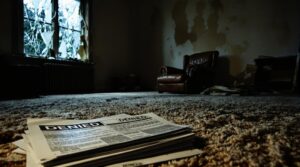Repairing water-damaged swollen wood floors begins with immediate water extraction using a shop vacuum. A combination of dehumidifiers and ventilation fans accelerates the controlled drying process, which must achieve moisture content below 15%. Assessment with moisture meters determines the extent of damage. Severely damaged boards require removal and replacement with matching materials. Professional-grade sanders prepare the surface for multiple coats of water-resistant finish. The complete restoration process involves additional essential steps for long-term protection.
Key Takeaways
- Remove standing water immediately using a shop vacuum and deploy dehumidifiers and fans to thoroughly dry the affected area.
- Test moisture content with specialized meters until readings fall below 15% before attempting repairs.
- Remove damaged floorboards carefully using a circular saw and pry bar, ensuring surrounding boards remain intact.
- Replace affected sections with matching floorboards, secure with finishing nails, and sand the area smooth.
- Apply multiple coats of water-resistant finish after repairs, allowing adequate drying time between applications.
Understanding Water Damage in Hardwood Floors
When water damage occurs in hardwood floors, it triggers a cascade of destructive processes that can compromise both the aesthetic appeal and structural integrity of the flooring. Understanding wood properties is vital, as wood naturally absorbs moisture, leading to swelling, warping, and potential buckling of the floorboards. High temperatures combined with excessive moisture can cause floorboards to develop raised humps over time.
The effects become visible through staining, discoloration, and lifting nails. Identifying water sources promptly is essential for preventing extensive damage. Whether from leaks, spills, or high humidity, prolonged exposure can result in irreversible deterioration.
As moisture penetrates the wood fibers, it creates conditions conducive to mold and mildew growth, often accompanied by musty odors. The damage extends beyond surface level, potentially weakening the adhesive bonds between the hardwood and subfloor, compromising the floor's structural stability and necessitating immediate intervention.
Essential Tools and Materials for Floor Repair
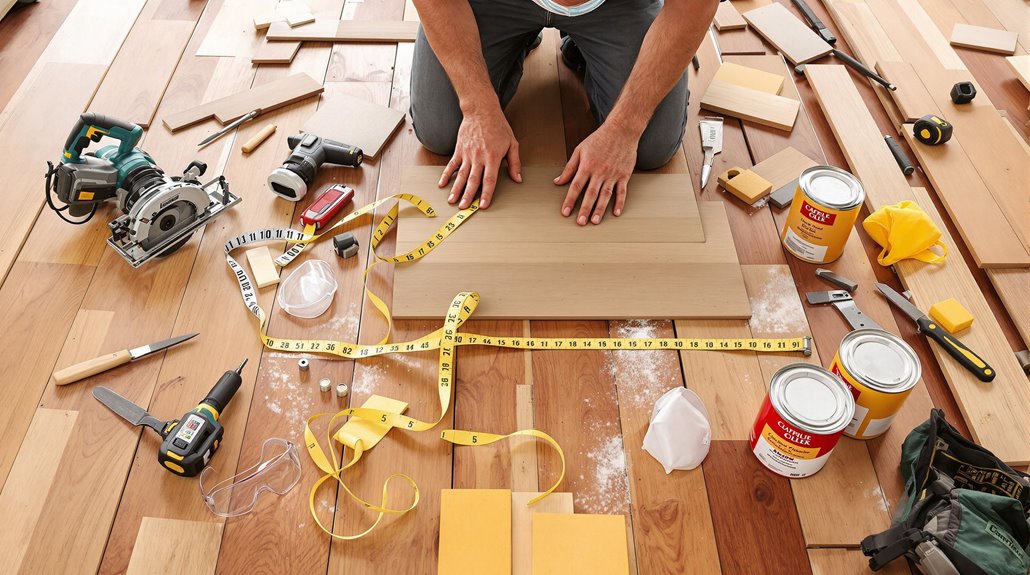
Repairing water-damaged wood floors requires a thorough set of specialized tools including a circular saw, drill with spade bit, pry bar, and measuring tape for accurate board removal and replacement. Moreover, once the damaged floorboards are removed, it’s essential to assess the underlying structure to ensure it’s not compromised. This often involves employing repairing water damaged subfloor techniques to address any moisture-related issues and prevent future problems. After the subfloor is secured, new planks can be installed using the same specialized tools, ensuring a seamless and durable restoration of your wood floors.
The necessary wood treatment supplies encompass matching replacement floorboards, finishing nails, appropriate sandpaper grits, color-matched stain, and polyurethane finish for surface protection. Using sharp chisels for precise cuts helps ensure clean removal of damaged sections without affecting surrounding boards.
Professional-grade safety equipment, such as goggles and dust masks, guarantees proper protection during the restoration process while additional materials like wood filler and moisture barrier paper address underlying damage and prevent future issues.
Basic Repair Equipment Needed
Successful repair of water damaged wood floors requires a thorough set of essential tools and safety equipment. The core toolkit consists of a circular saw, drill with spade bit, hammer, measuring tape, and pry bar for executing precise repair techniques.
Safety must remain paramount, necessitating protective gear including goggles, dust mask, safety glasses, gloves, and kneepads. A reliable moisture meter is essential for accurately assessing water damage levels before beginning repairs.
Specialized tasks demand additional implements such as a sharp chisel, utility knife, floor scraper, tapping block, and rubber mallet.
Equipment maintenance extends to cleanup tools, which include a vacuum cleaner, various grits of sandpaper, and optionally, a sanding machine.
A basic dust pan, broom, and shop vacuum complete the necessary arsenal for ensuring a clean, professional repair environment throughout the restoration process.
Wood Treatment Supplies Required
A thorough collection of wood treatment supplies forms the foundation of effective water damage restoration. The essential materials encompass both wood preservation techniques and moisture control methods. Key components include moisture-resistant adhesives, epoxy-based fillers, and specialized wood fillers for addressing structural damage.
For extensive floor treatment, protective finishes play an important role. These include oil-based sealants for water resistance, water-based polyurethane for clear protection, and UV-resistant coatings to prevent future deterioration. Stain-sealers provide dual functionality by combining color matching with protective properties.
Additionally, proper moisture control requires dehumidifiers and fans for drying, while cleaning agents and disinfectants prevent mold growth. Professional-grade restoration products complete the arsenal, enabling the revival of damaged wood surfaces to their original condition.
Evaluating the Extent of Floor Damage
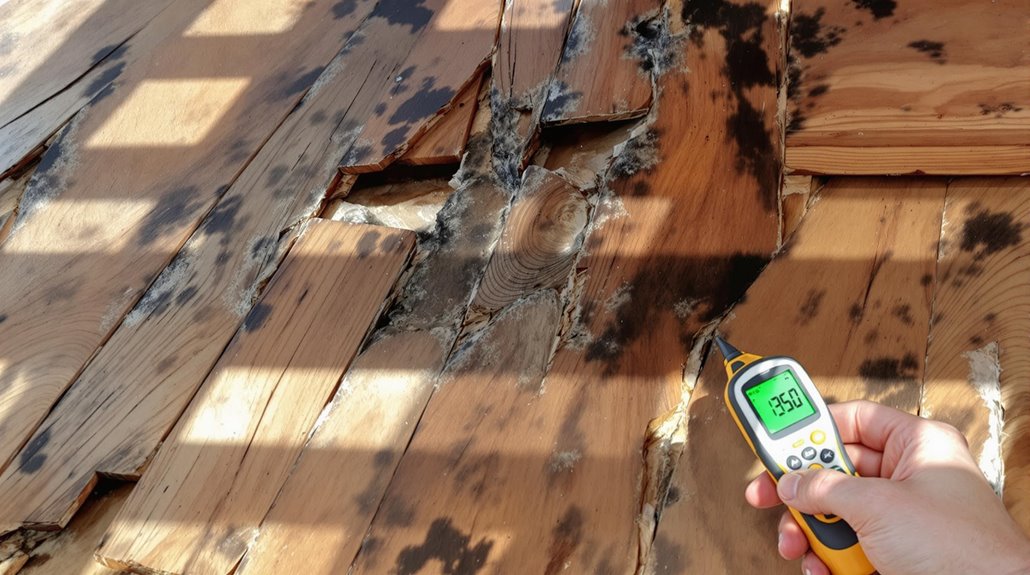
A thorough assessment of water-damaged wood flooring begins with identifying visible indicators such as buckling, discoloration, and mold growth.
Testing moisture content with specialized meters provides quantitative data about water retention in both the flooring and subfloor layers.
Evaluating structural integrity through physical inspection reveals critical issues like delamination, subfloor deterioration, and compromised load-bearing capacity.
Visual Signs of Damage
Professional assessment of water-damaged wood floors begins with a thorough visual inspection to identify key indicators of damage.
When evaluating wood flooring, experts look for several distinctive signs that indicate water exposure and potential structural compromise. Dark or discolored areas often signal prolonged moisture contact, while warped or buckled floorboards indicate severe water absorption. Common causes of these issues include flooding, plumbing leaks, and high humidity levels.
Additional visual indicators include blistered or peeling finish, which suggests moisture penetration beneath the surface coating. Loose or uneven boards, accompanied by squeaking or movement when walked upon, signal potential subfloor damage.
Preventative measures should be implemented immediately upon discovering these signs to minimize further deterioration and protect the floor's structural integrity.
Measuring Moisture Content
Accurate moisture content measurement serves as a critical diagnostic tool for evaluating water-damaged wood floors.
Professional moisture detection involves using both pin-type and pinless meters to obtain thorough readings. Pin-type meters provide precise measurements by penetrating the wood, while pinless meters enable rapid surface scanning for initial assessments.
For ideal reading accuracy, inspectors should establish baseline measurements from unaffected areas before testing damaged sections. Normal moisture content typically ranges between 5-10%, with readings above 15% indicating potential mold risk. Levels exceeding 18% can compromise structural integrity through metal fastener corrosion.
When conducting assessments, specialized equipment like insulated hammer probes enables moisture measurement at various depths, while dielectric meters help create detailed damage maps. This data guides restoration professionals in developing targeted repair strategies.
Testing Floor Structure Integrity
Thorough evaluation of floor structure integrity requires systematic inspection of visible damage indicators and underlying structural components.
A detailed structural assessment begins with examining surface deformities like warping, buckling, or cupping, which signal potential deeper issues.
Using probe testing techniques with a screwdriver or awl helps identify soft spots and areas of decay.
Moisture detection tools, including professional-grade meters and thermal imaging cameras, reveal hidden water damage within the floor structure.
Inspectors must examine floor joists and subfloor materials for deterioration while evaluating their load-bearing capacity.
Special attention should be given to foundation cracks and drainage issues that may compromise the floor's structural stability.
This evaluation process guarantees accurate identification of both visible and concealed damage before proceeding with repairs.
Removing Standing Water and Moisture
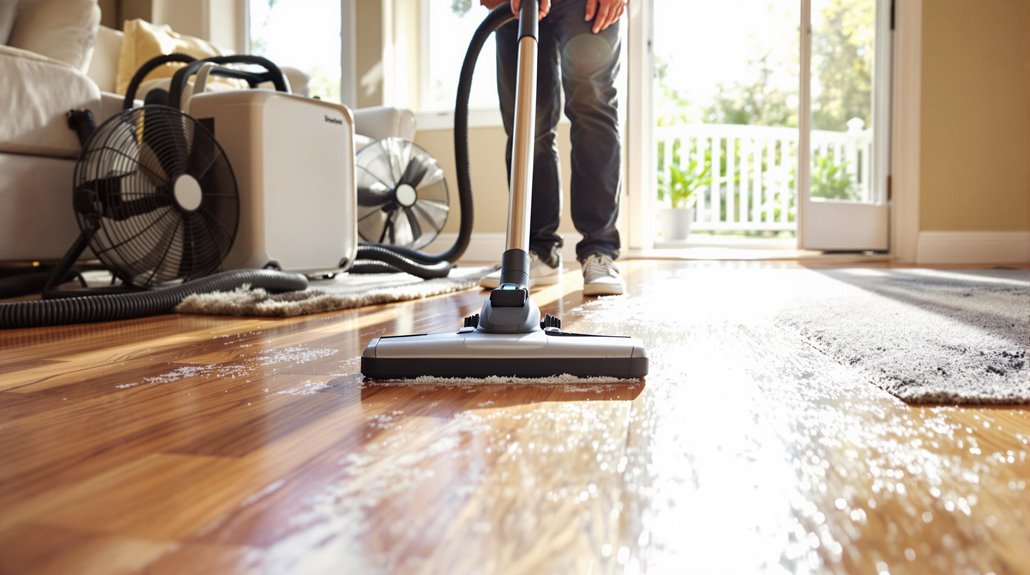
When water damage occurs on hardwood floors, swift removal of standing water becomes the critical first step in preventing extensive damage.
Water extraction methods should begin immediately using a shop vacuum, continuously running it over affected areas until no water appears in the canister. Supporting tools like towels and mops help address smaller puddles and spills.
Moisture control techniques involve strategic deployment of dehumidifiers at maximum settings for at least 24 hours, alongside ventilation fans to accelerate the drying process.
Simultaneously, all wet furniture, rugs, and objects must be relocated to prevent further floor saturation. The thorough approach includes thorough cleaning with soap and water solution after water removal, followed by inspection for signs of damage such as discoloration, cupping, or buckling.
Proper Drying Techniques and Timelines

Strategic airflow control requires placing fans and dehumidifiers at ideal angles to facilitate moisture evaporation from wood floors while continuously measuring moisture content with a professional-grade meter.
Professional restoration experts recommend monitoring moisture levels daily and documenting readings to track progress until the floor reaches its acceptable moisture content range of 6-12%.
Gradual drying prevents warping and splitting, as rapid moisture removal can cause irreversible structural damage to wood fibers.
Maximize Air Flow Methods
Proper air circulation plays a critical role in salvaging water-damaged wood floors and preventing long-term structural issues.
Implementing effective air circulation techniques involves strategic fan positioning strategies and the creation of cross-ventilation patterns throughout the affected area.
To maximize airflow and accelerate the drying process:
- Position multiple fans at different angles, directing air across the wood surface while maintaining consistent movement patterns.
- Create a cross-ventilation system by opening windows and doors on opposite sides of the room, establishing natural air exchange.
- Place dehumidifiers near areas with highest moisture concentration, ensuring they work in conjunction with fan placement.
- Establish containment zones using 6-mil poly sheeting to channel airflow specifically toward damaged sections while maintaining ideal drying conditions.
Monitor Moisture Progress Daily
Effective moisture monitoring serves as the cornerstone of successful wood floor restoration after water damage. Using both pin-type and non-invasive moisture meters, technicians must track daily readings to guarantee ideal drying progress and prevent potential complications.
The monitoring process requires systematic documentation of moisture levels across different floor sections. This data enables precise adjustments to drying strategies, from repositioning air movers to modifying dehumidifier settings.
Temperature and humidity measurements, often obtained through infrared thermometers and thermal imaging, provide additional insights into the drying environment.
Drying duration varies considerably, ranging from 24 hours to several weeks, depending on damage severity. Regular moisture checks prevent both under-drying, which risks mold growth, and over-drying, which can cause structural issues like warping or cracking.
Avoid Rapid Drying Damage
While rapid drying may seem like an expedient solution for water-damaged wood floors, controlled and systematic drying techniques are essential to prevent additional damage.
Excessive moisture retention can lead to warping, while over drying effects include cracking and splitting. Creating a contained environment with proper moisture monitoring helps maintain ideal drying conditions.
Key indicators of improper drying include:
- Material separation and gapping between boards
- Surface cracking and checking patterns
- Cupping or crowning of individual planks
- Visible structural deformation at board edges
Utilizing moisture meters to maintain 6-8% moisture content, coupled with thermal imaging for temperature monitoring, guarantees proper drying progression.
Professional-grade dehumidifiers and panel drying systems provide controlled moisture removal, while avoiding direct heat sources prevents localized damage to the wood surface.
Professional Vs DIY Repair Methods
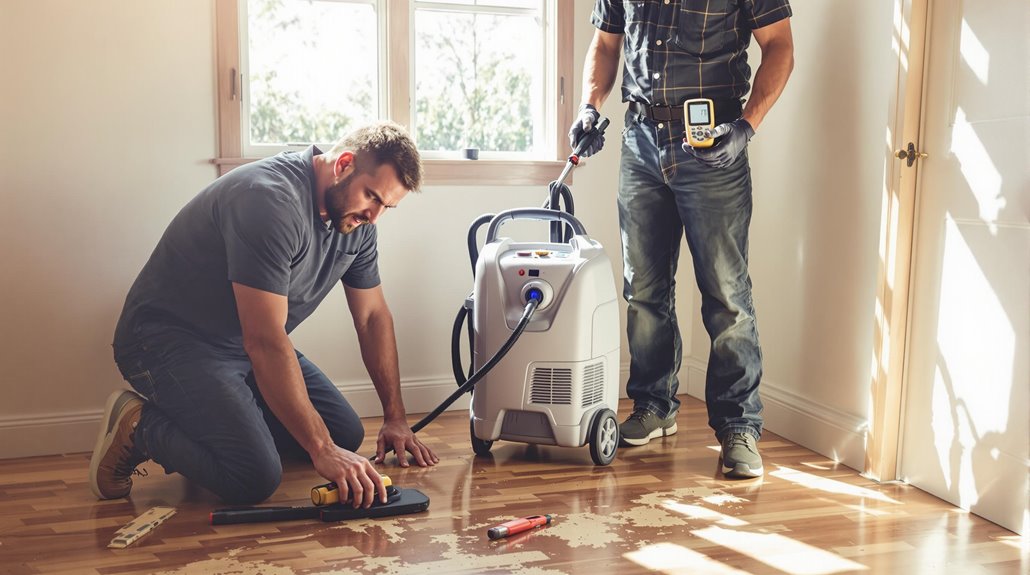
The decision between professional and DIY repair methods for water-damaged wood floors hinges on several critical factors, including the extent of damage, available resources, and urgency of repair.
DIY limitations become apparent when dealing with extensive water damage, as homeowners often lack specialized equipment and expertise to detect hidden moisture and guarantee thorough drying.
Professional advantages include access to industrial-grade dehumidifiers, moisture meters, and detailed assessment capabilities.
While DIY repairs might seem cost-effective initially, they can lead to incomplete restoration and subsequent problems like mold growth or structural weakness.
Professional services offer efficient drying techniques, preventive measures against further damage, and typically provide warranties for their work.
For severe water damage, professional intervention guarantees lasting results and maintains the floor's integrity through proper restoration procedures.
Similar to public adjusters' expertise, professional floor restoration specialists can navigate complex insurance claims while executing proper repairs.
Steps to Sand and Refinish Damaged Areas
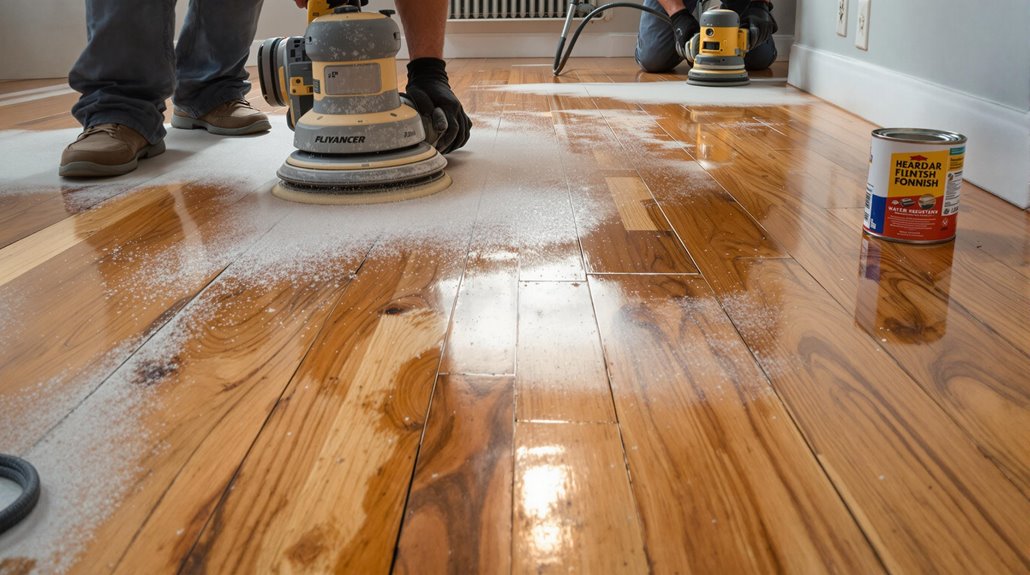
Restoring water-damaged wood floors through sanding and refinishing requires a systematic approach beginning with thorough preparation.
After confirming the floor is completely dry, the process involves specific sanding techniques progressing from coarse to fine-grit sandpaper to achieve ideal results.
Essential steps in the refinishing methods include:
- Using a drum sander for large areas while maintaining consistent movement in the grain direction
- Employing an edge sander for perimeter work and hand-scraping corners
- Cleaning thoroughly between grits with vacuum and tack cloth
- Applying multiple coats of water-resistant finish with proper drying time
The restoration process concludes with a careful inspection of the refinished surface and application of protective sealers to prevent future water damage.
This methodical approach guarantees the damaged wood floor returns to its original condition while establishing better resistance to moisture.
Fixing Gaps and Replacing Damaged Planks
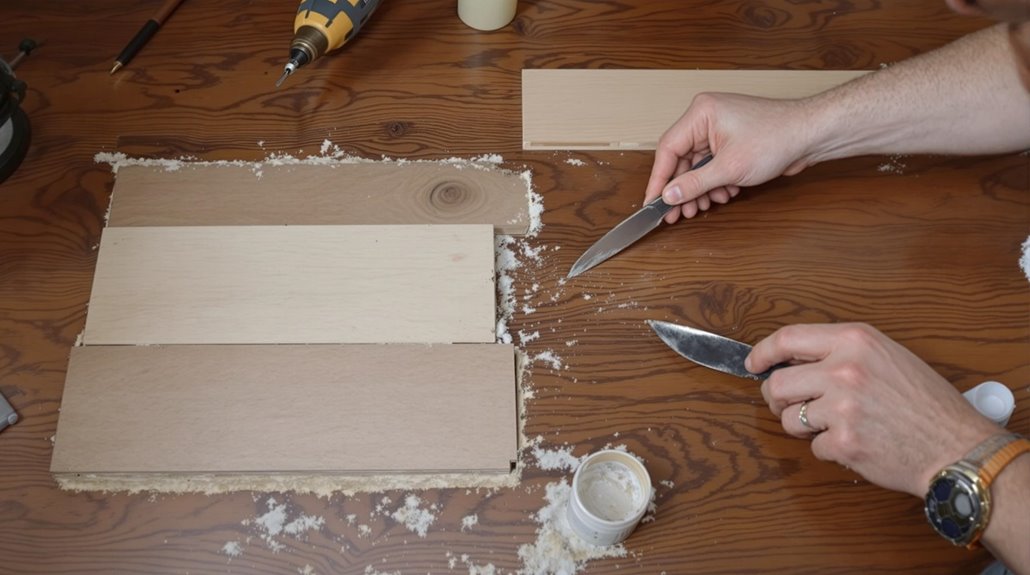
Successfully addressing gaps and replacing damaged planks in water-damaged wood floors requires systematic assessment and precise execution of repair techniques.
The process begins with a thorough inspection to identify warped areas, followed by gap filling using wood filler applied in thin layers and sanded to match surrounding surfaces.
For plank replacement, damaged sections must be carefully removed using relief cuts and strategic drilling.
After cleaning the exposed area of debris and old adhesive, replacement planks are precisely cut to size with modified tongue and groove edges.
Installation involves applying appropriate adhesive to connecting surfaces and carefully tapping the new plank into position.
The process concludes with securing the replacement using 23-gauge pins, ensuring structural integrity and seamless integration with the existing floor.
Applying Protective Finishes and Sealants
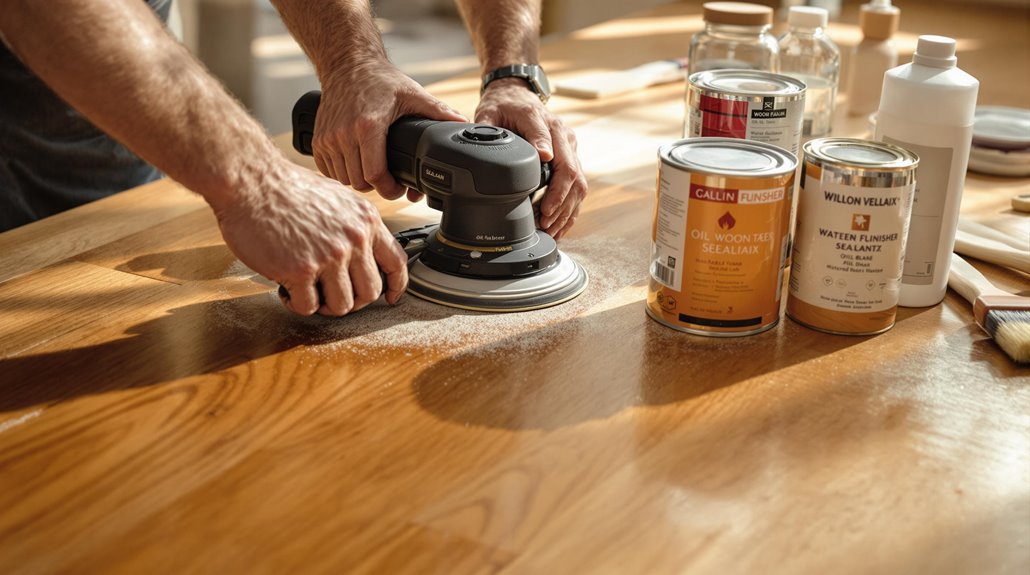
Following water damage repair, proper application of protective finishes and sealants serves as a critical final step in preventing future moisture-related issues.
Different sealant types offer varying levels of protection, with water-based sealers providing quick-drying, environmentally friendly solutions, while oil-based options deliver enhanced shine and durability.
Key protective finishes for water damage prevention include:
- Varnish for general moisture protection
- Hard wax oil for high-moisture areas like bathrooms
- Polyurethane sealants for long-lasting durability
- Water-based sealers for quick-drying, non-yellowing results
Selection should consider the specific wood type, humidity levels, and intended use.
Water-based products typically require more frequent reapplication but offer safer application, while oil-based finishes provide longer-lasting protection despite longer drying times and stronger fumes.
Prevention Tips and Maintenance Strategies
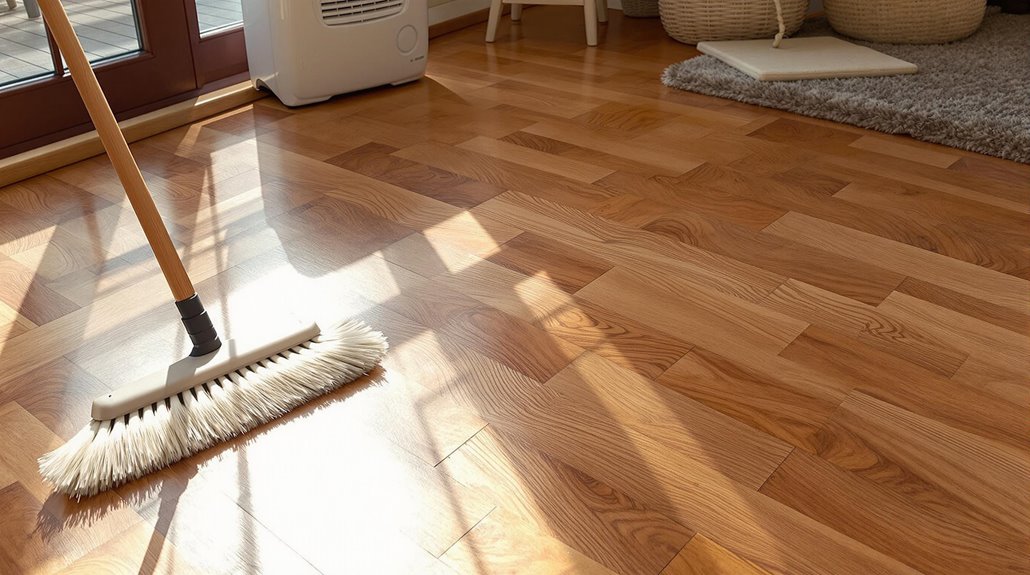
While repairing water-damaged wood floors remains vital, implementing thorough prevention and maintenance strategies can greatly reduce the risk of future moisture-related issues.
Effective wood floor maintenance begins with regular inspections of potential water sources, including pipes, roofs, and window seals. Daily cleaning should utilize soft-bristled brooms or microfiber mops, avoiding excess moisture during cleaning processes.
Humidity management plays an essential role in prevention, requiring the use of humidifiers during winter months and dehumidifiers in summer to maintain ideal levels between 35-55%.
Strategic placement of mats and rugs in high-risk areas provides additional protection. Long-term preservation involves scheduled refinishing every 3-5 years, consistent use of furniture pads, and immediate attention to spills or signs of moisture damage.
The Benefits Of Consulting A Public Adjuster
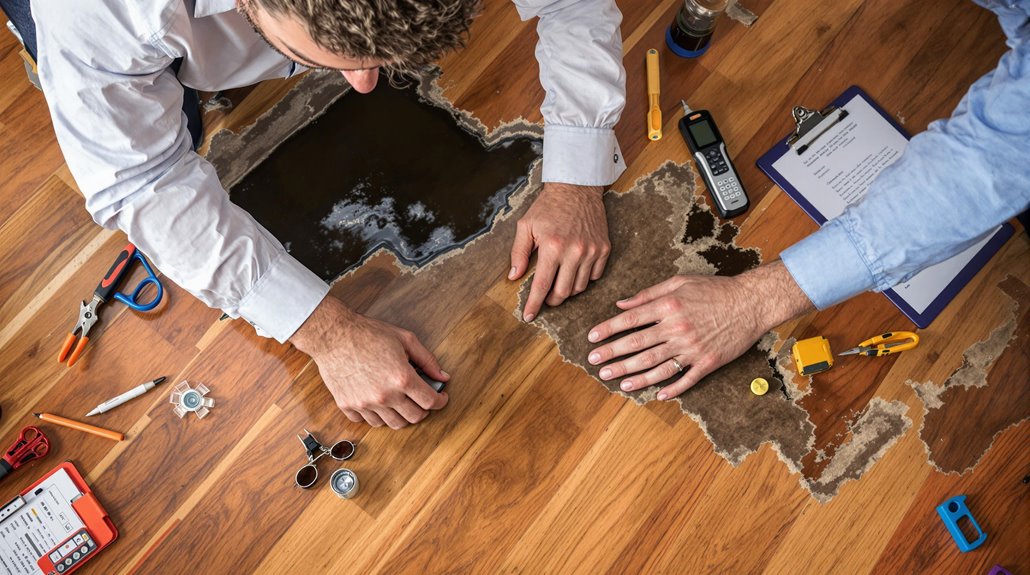
Consulting a public adjuster provides critical expertise in managing complex insurance claims for water-damaged wood floors.
Their objective assessment methodology and thorough documentation practices help identify both visible and hidden damage while ensuring proper valuation of losses.
Through their professional management of the claims process and negotiation capabilities, public adjusters typically secure higher settlement amounts compared to policyholder-handled claims.
Operating on a contingency fee basis, public adjusters charge 5-20% of the final settlement amount while delivering specialized knowledge of insurance policies that helps maximize claim payouts.
Expertise In Insurance Claims
Steering insurance claims for water-damaged wood floors requires specialized expertise that public adjusters can provide. These professionals possess extensive knowledge of insurance policy terms and navigate the claim process with precision, guaranteeing maximum coverage for floor restoration.
Their expertise includes interpreting complex policy language and understanding legal requirements specific to water damage claims.
Key areas of expertise include:
- Detailed documentation of water damage extent and impact on wood flooring
- Analysis of policy coverage specific to water-related incidents
- Assessment of long-term implications for floor integrity
- Strategic claim presentation to guarantee full compensation
Public adjusters apply their technical knowledge to develop thorough claims that account for both immediate repairs and potential future complications.
Their objective approach and thorough understanding of insurance procedures help secure appropriate settlements for wood floor restoration projects.
With average annual earnings of $61,465, public adjusters provide professional expertise while maintaining competitive rates for their services.
Objective Damage Assessment
Because accurate damage evaluation forms the foundation of successful insurance claims, public adjusters employ systematic assessment protocols to document water-damaged wood floors.
Their thorough damage analysis utilizes advanced assessment techniques, including moisture meters and thermal imaging, to uncover both visible and concealed deterioration.
These professionals conduct detailed inspections to identify secondary effects like moisture seepage and potential mold growth within the flooring structure.
Through meticulous documentation supported by photographic evidence, public adjusters build robust claims that accurately represent the full scope of damage.
This methodical approach enables them to counter insurance company tactics aimed at minimizing payouts and guarantees policyholders receive appropriate compensation for their losses.
Their expertise in maneuvering policy terms and negotiating with insurers proves invaluable in securing fair claim resolutions.
With settlement rates increasing significantly when public adjusters manage claims, homeowners can expect better compensation for their water-damaged floors.
Streamlined Claim Process
Professional public adjusters greatly streamline the insurance claim process for water-damaged wood floors through systematic documentation and expert policy interpretation. Their thorough management guarantees insurance compliance while reducing claim filing complexities and potential settlement delays.
- Handle intricate policy requirements and documentation deadlines
- Coordinate with contractors and insurance representatives
- Review settlement offers to secure fair compensation
- Manage technical assessments and damage documentation
Public adjusters shoulder the administrative burden, allowing property owners to focus on recovery. Their expertise in traversing insurance procedures minimizes the risk of claim denials due to procedural oversights. Since they work on a commission-based model, public adjusters are inherently motivated to secure the maximum possible settlement for water-damaged floors.
Higher Claim Payouts & Settlements
Statistical evidence demonstrates that property owners who engage public adjusters receive considerably higher settlements for water-damaged wood floors.
Data shows settlements averaging $22,266 with public adjusters, compared to $18,659 without their services.
This increased settlement potential stems from several key factors. Public adjusters excel in claim negotiation through their thorough damage assessments and detailed documentation practices.
Their policyholder advocacy guarantees all eligible damages are identified and properly valued. Working on a contingency basis, these professionals are incentivized to maximize claim values while leveraging their expertise in local insurance laws and industry standards.
Their objective perspective and professional experience enable them to identify often-overlooked damage components, while their established relationships with specialists and contractors strengthen the validity of repair estimates.
About The Public Claims Adjusters Network (PCAN)

The Public Claims Adjusters Network (PCAN) represents a coalition of licensed insurance professionals who specialize in advocating for policyholders during insurance claims processes.
These experts streamline the claim process through thorough support services and proven expertise in policy interpretation.
Key features of PCAN include:
- 24/7 call center support for immediate claim assistance
- International network of licensed adjusters across multiple continents
- Customized solutions tailored to specific claim requirements
- Decades of combined experience in claims management
PCAN professionals handle all aspects of water damage claims, from initial assessment to final settlement negotiations.
Their expertise guarantees proper documentation, accurate damage evaluation, and maximum claim recovery, while maintaining clear communication between policyholders and insurance companies throughout the entire process.
Frequently Asked Questions
Can I Use a Regular Vacuum Instead of a Wet Vacuum?
Like playing with fire, using a regular vacuum for liquids is dangerous. Different vacuum types require specific cleaning techniques – regular vacuums can be damaged or pose electrical hazards with water.
Will My Homeowner's Insurance Cover Water-Damaged Hardwood Floors?
Homeowner's coverage typically includes water damage to hardwood floors from sudden events like burst pipes. Long-term leaks, poor maintenance, or flood damage may require separate insurance or be excluded.
How Do I Match the Color of Replacement Boards Perfectly?
Like mixing paint on an artist's palette, perfect color matching requires experimenting with wood stains on sample boards, water-popping the wood, and testing under various lighting conditions before final application.
Can I Speed up Drying by Using Portable Heaters?
Portable heaters can accelerate drying when used cautiously with proper heat distribution. Combining multiple drying methods like dehumidifiers and fans guarantees safer, more controlled moisture removal than heaters alone.
Should I Remove Baseboards Before Starting the Repair Process?
An ounce of prevention is worth a pound of cure. Baseboard removal is essential before initiating repair processes, as it enables thorough inspection of hidden damage and guarantees proper drying of affected areas.
References
- https://usvintagewood.com/buckled-wood-floors-causes-and-fixes/
- https://www.restoration1.com/rancho-cucamonga/blog/how-to-fix-wood-floor-water-damage
- https://sanding-wood-floors.co.uk/restoring-water-damaged-wood-floors/
- https://www.puroclean.com/schwenksville-pa-puroclean-lansdale/blog/how-to-fix-a-water-damaged-wood-floor-a-step-by-step-guide/
- https://tottahardwoods.com/repairing-a-water-damaged-hardwood-floor/
- https://jenkinsrestorations.com/how-to-minimize-and-repair-water-damage-to-wood-floors/
- https://www.fromtheforest.com/blogs/fromtheforest/signs-that-your-wood-floors-are-water-damaged
- https://www.alldryus.com/blog/water/water-damaged-wood-floors/
- https://www.drymedic.com/blog/how-long-does-it-take-water-to-damage-wood-floors/
- https://romerohardwoodfloor.com/how-to-repair-a-water-damaged-hardwood-floor/


